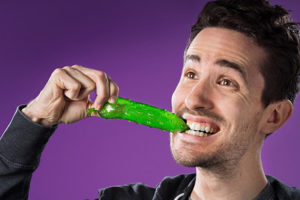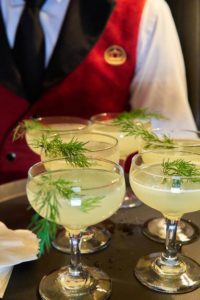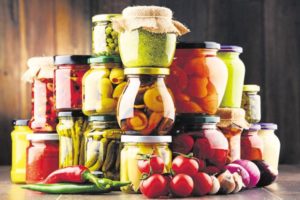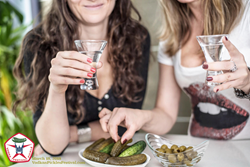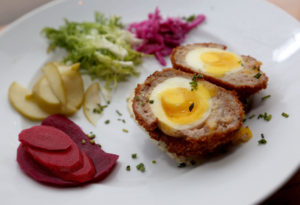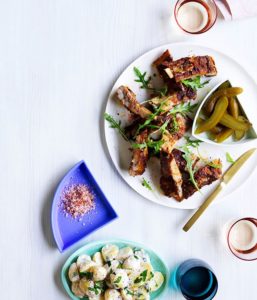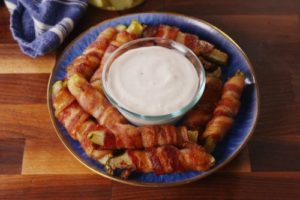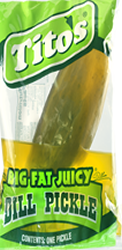
A pickle stall at Nishiki Market in Kyoto.
The practice of fermentation in food can be traced to the very beginnings of civilisation when early humans discovered an alchemy that allowed them to preserve ingredients so they could be eaten year-round. Almost every culture on earth practises fermentation in some way.
But in Japan, fermentation is integral to the food culture, with fermented foods often regarded as the “soul” of Japanese cuisine, and they have been part of the daily diet for centuries.
Beyondtsukemono (pickles, of which there are many types and methods), ingredients like shoyu (soy sauce), miso, umeboshi (salted plums), katsuobushi(fermented and smoked skipjack tuna integral to dashi stock), natto(fermented soy beans), sake, mirin, vinegars and amazake are all fermented. Koji (Aspergillus oryzae) is so intrinsic to many of these foods that it has recently been declared a national fungus.
Japanese cuisine is often regarded as one of the world’s healthiest, and fermented foods can be credited with playing a significant role in this. Fermented foods (that haven’t been pasteurised) are teeming with probiotics, millions of beneficial bacteria and enzymes that stimulate digestion and improve gut health. They also have positive effects on blood pressure and cholesterol, and some experts in Japan believe certain fermented ingredients provide relief from fatigue, anxiety and depression, and even have anti-cancerous properties. In Okinawa, they drink a fermented turmeric tea that is believed to be the key to the incredible longevity of the population.
My fascination with fermentation began in Japan. Five years ago, on my first visit, I found myself in a tiny sake bar called Yoramu in Kyoto where they served fresh tofu with a tiny dollop of a chilli paste called kanzuri. It changed my life. I have since returned to Japan every year to travel, eat and dig deeper into the incredibly rich culture.
Kanzuri is made in Niigata prefecture, which sits along the Sea of Japan. The climate and “long white winter” there has meant that fermentation and preservation has long been an essential part of the local diet — allowing fruits and vegetables to be eaten year-round. In more recent times — three to four generations — they have adapted their techniques by burying the vegetables in snow houses — called yukimuro. By doing this they have discovered the natural refrigeration and steady humidity draws out the natural sugars and increases the levels of amino acid. Kanzuri is equal parts hot, salty, citrusy and umami. I have dedicated my life to trying to replicate it.
The following are a few of the ingredients, techniques and people I was fortunate to meet on my last visit to Japan, offering a small glimpse into the importance of fermentation in Japanese cuisine.
Sake
Terada Honke is located in the small town of Kozaki in Chiba prefecture, where they have been brewing sake since 1673. Terada Masaru grows his own rice and supplements it with the produce of other small organic growers in the area. His naturally brewed sake is completely handmade in the age-old Kimoto method and consists of three ingredients: rice, water and koji. I felt incredibly honoured to visit and learn the process and finish with a sake tasting perfectly matched with fresh tofu from across the road.
Nancy Singleton Hachisu is the author of Preserving the Japanese Way — one of my favourite books. American-born and married to a Japanese farmer, she has lived in rural Saitama for 30 years. It was a real privilege to visit her on her farm and talk preservation and the role of fermented foods in Japan. She also took me to Yamaki Jozo, a local producer of shoyu, miso, tofu and tsukemono.
Yasutaka Kijima is a sixth-generation koji and miso-maker in Shimizu. His family has been producing in the same location for more than 180 years. As in the case of his forefathers, his is a manual and instinctive operation — his finger is his thermometer. My kind of fermentation.
At Kijima Kouji, koji is made in 100kg batches — some sold in bags (for the price of a packet of crisps) and the rest turned into miso. He sells both from the little shop he runs with his elderly mother. The sad thing is he is the end of the line.
His children aren’t interested in taking over the family business because there’s no money in it. Mass production and changing diets have hit his business hard. His family business will close its doors when he can no longer keep up the significant workload required to make ends meet. I was half-jokingly offered an apprenticeship.
Pickles
Shibazuke is my favourite pickle … ever. One of my highlights of the trip was visiting the birthplace of the tsukemono, with all organic ingredients grown on site. Tami and Yuto have a beautiful farm nestled in the mountains north of Kyoto. They sell their vegetables at the local farmers market and ferment the significant excess of eggplant, cucumber and shiso the authentic way. The pickle bears little resemblance to the preservative-rich, MSG-laden, luminous purple product readily available throughout Kyoto.
“Shiba” means firewood, and the story goes that back in the day women used to walk 15km each way, sometimes twice a day, with firewood stacked on their heads to sell in Kyoto. They would also fill their pockets with the distinctive pickle to sell or trade to supplement their income. I can only hope the men were being useful.
Sugukizuke is another of the quintessential pickles of Kyoto (along with shibazuke and senmaizuke). Made from a variety of turnip called sugukina, its legitimate production is limited to the area of Kamigamo where it has been made for more than 300 years. Its first recorded history traces its origins to Kamigamo shrine. Gaining access to see it made was a challenge in itself as the families making suguki keep their methodology extremely close to home. I was very lucky to be invited (through friends of friends of friends) to visit master-pickler Hajime Watanane, and he talked me though the entire process: from growing the turnips through to the extensive and somewhat complicated fermentation. The results are amazing — crunchy, lactic and so delicious. Again, an entirely different product to what is generally found in the markets.
Soy sauce
Today in Japan only 1 per cent of shoyu is still made the traditional way — not mass produced, and free from the preservatives and flavour enhancers that dominate not only shoyu production but many (once artisanal) fermented foods. Of this 1 per cent, only a handful still use the original cedar barrels (kioke) for fermentation. The ones at Yamaroku on the island of Shodoshima were made in 1868 and hold 6000 litres each. The soy beans are grown on the island and the moromi is fermented for between two and four years before being pressed. The recipe has remained unchanged for five generations and, according to present owner Yasuo Yamamoto, “time is the only way to make the best flavour”. The place reeks of umami in a really good way.
Fermented sushi
Probably the most fascinating (and challenging) ferment of the trip was fermented sushi — narezushi. Sushi as we know it came from fermenting crucian carp in rice, then discarding the rice once the fish was preserved. The practice is believed to have started in the 8th century around lakes Biwa and Yogo in Shiga prefecture.
The tradition was largely abandoned during the Edo era and now lives on via a select few around lake Yogo (about two hours north of Kyoto). Tokuyamazushi is a beautiful restaurant sitting beside the lake surrounded by mountains and forest. Chef Hiroaki Tokuyama feeds 15 people a day with a set menu highlighting his fermented fish. His process is traditional, using only natural ingredients: 12 months salting the fish, then fermenting for between seven and nine months in koji-inoculated koshihikari rice. He is now beginning to experiment with other (non-lake) fish such as mackerel.
The flavour is intense: very acidic, blue cheesy, yoghurts, fishy. Hiroaki-san serves the fish in the rice it was fermented in, which by this stage has broken down to a thick congee-like consistency — it kind of softens the blow. I initially gagged — but out of respect “took one for the team” and finished not only my portion but also my guide’s and translator’s serves.
While I can’t say I loved it — it was unlike anything I had tasted before — what resonated from the experience was not only that a tradition is being kept alive but that this is now considered one of the greatest delicacies in Japanese cuisine. Tokuyamazushi is one of the hardest restaurants to get a reservation for, and is generally booked out a year in advance.
Adam James (@roughrice) is a cook and fermenter from Hobart. He has just completed a three-month, six-country Churchill Fellowship research trip in search of all things fermented.

